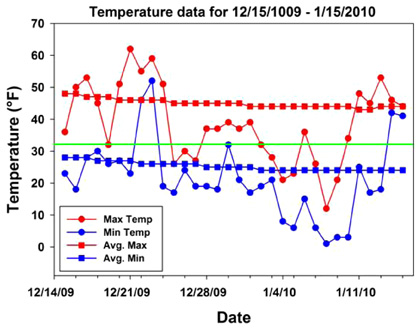Winter Kill - 2010 - Part 1
Winterkill 2010?
With colder than normal temperatures in Arkansas this winter, we are anticipating
that some of our turfgrasses around the state may suffer from winterkill. To help
prepare for this we are publishing a four part series on this topic to help turfgrass
managers prepare for what may await them in the spring. Look forward to the following
topics over the next four weeks.
Part I: Predicting the damage: What causes winterkill and how can we estimate our
losses?
Part II: Preparation and recovery: What should you do or not do this spring to help
your turf?
Part III: Planning and planting improved cultivars for a better future.
Part IV: Practices to enhance winter survival.
--
January 18, 2010
Part I: Predicting the damage: What causes winterkill and how can we estimate our
losses?
Predicting winterkill is a difficult task because turf can suffer low temperature
injury in a variety of ways. The three most common ways that turfgrasses sustain low
temperature injury are:
- Sustained low temperatures
- Low temperature spikes
- Unseasonably warm temperatures followed by freezing temperatures
Sustained low temperatures. Recently we fell in this category when unseasonably cold temperatures hit and stayed
put for a two week time period. During this period numerous records were set for low
temperatures, but possibly more important; the average temperatures were 10-15 °F
below normal.
During this period temperatures in Little Rock fell below 10 °F, which is a temperature
at which many St. Augustinegrass cultivars succumb to winter injury. In northern Arkansas,
temperatures fell just below 0 °F in some areas which could mean trouble for some
bermudagrasses.

Low temperature spikes. In many cases turfgrasses can survive one or two nights of very cold temperatures
because soil temperatures are more highly buffered than air temperatures and do not
change as rapidly. Some turfgrass species such as zoysiagrass and bermudagrass have
underground stems (rhizomes) which are insulated from the air temperatures and may
allow them to withstand sudden drops in air temperatures. Other grasses like St. Augustinegrass
only have above ground stems (stolons) and are not immune from low temperature spikes.
Unseasonably warm temperatures followed by freezing temperatures. Warm-season grasses such as bermudagrass enter winter dormancy in late October or
November and stay in this winter dormancy until March or April. If their winter dormancy
in interrupted by unseasonably warm temperatures in November-December or in February-March
and is then followed by freezing temperatures, winter injury will usually result.
Some grasses such as centipedegrass is especially susceptible to this type of injury
and that is why it is only recommended for use in southern and central Arkansas.
Plant cells are protected from freezing stress by many mechanisms including the accumulation
of certain proteins and enzymes as well as certain sugars and amino acids. When winter
dormancy is interrupted by a period of unseasonably warm temperatures, the balance
of these protectants in the plant cell changes and predisposes them to greater injury
if freezing temperatures follow.
Which areas are more likely to suffer winterkill?
- North facing slopes
- Heavily shaded areas
- Poorly drained areas
- Areas planted with poorly adapted cultivars
- Areas trafficked during winter
- Areas with deficient levels of soil potassium (K)
How can we estimate our losses? To help determine just how much winter injury you might have following these steps.
- Collect samples using a cup cutter or device from areas that you feel may be damaged (shaded areas) as well as from other areas not likely damaged (full sun, south facing slopes; areas planted with a cold tolerant cultivar/specie). Make sure that the sample you collect is at least 3 inches in diameter and is at least three inches deep.
- Clearly label each sample denoting the date and location where it was collected.
- Place the samples in a warm area (room temperature or above). Provide lighting and water the plugs when necessary.
- Observe the plugs over the next two weeks. If the plants are alive they should start to green-up within 7 days. Differences in green-up between plugs collected from different areas should provide information on whether the plants survived the freezing temperatures. This will help as you begin to make decisions and plan for the future.
Drs. Aaron Patton and Mike Richardson